Cable repair in the wall for years - that is, roast me electrode :)
I tried very hard ... renovation, finishing, tiredness ... hit me too.
The cable is cut solidly, in such a stupid place that I am ashamed to admit that I marked the place for a new box myself. Let's do it for fatigue and that's the end of the topic.
I decided to document the repair process so as to take advantage of this fact and officially write on the electrode how, in my humble opinion, you can properly connect the cables in the wall, if you want to avoid the box. The subject is called "roast me" because I know what writing about THESE things on the electrode can be.
Luck - the condition is such that I can easily remove and replace the cable part for the top box.
I decided to deal with the matter systematically and neatly.
For various reasons, I did not want to connect the cable in the box. Cables for the socket circuit in the kitchen, so the nominal load of 16 A is quite real. I decided to start the repair properly so that I could easily forget about the problem.
Cable cut, peeled about 2 cm of wires. The cable is cleaned of rubbish with a cleanser.
And a twisted pair recommended by some, and a condemned by others, and how to make it, to the best of my knowledge, properly:

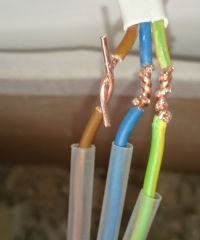
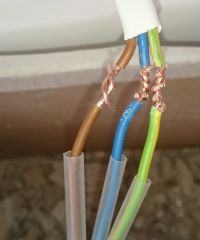

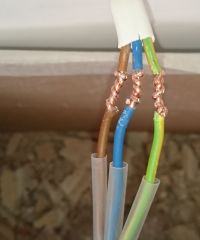
I would like to add that the cable is 2.5 mm?, so it was not twisted with your fingers. In this case, I recommend two pliers or pliers - one holds and the other curls.
I have a liking for the part of the forum in favor of a twisted pair? Or maybe the twisted pair is not like that? I admit that I pulled the zero cable slightly - I caused a part of the cable to break some 3-4 mm from the end. I have already decided to forgive this mistake and not take everything apart.
Well, now supporters of the twisted pair will begin to thunder - I do not trust the twisted pair for the sockets, there is such a machine:
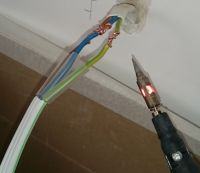
By the way - I highly recommend this solution. From getting to know gas soldering irons, I don't want to look at transformer tubes anymore. I do not know a more convenient solution (in field conditions).
And soldered:

Further no surprise - cleaning:

After cleaning - you probably don't see much difference in the photo, but the flux residues have been thoroughly removed:
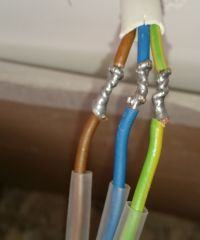
And putting on T-shirts:


The final T-shirt to recreate the outer insulation is a T-shirt with an adhesive:
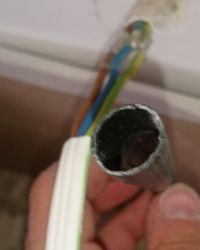
The final result:

The cable is cut solidly, in such a stupid place that I am ashamed to admit that I marked the place for a new box myself. Let's do it for fatigue and that's the end of the topic.
I decided to document the repair process so as to take advantage of this fact and officially write on the electrode how, in my humble opinion, you can properly connect the cables in the wall, if you want to avoid the box. The subject is called "roast me" because I know what writing about THESE things on the electrode can be.
Luck - the condition is such that I can easily remove and replace the cable part for the top box.
I decided to deal with the matter systematically and neatly.
For various reasons, I did not want to connect the cable in the box. Cables for the socket circuit in the kitchen, so the nominal load of 16 A is quite real. I decided to start the repair properly so that I could easily forget about the problem.
Cable cut, peeled about 2 cm of wires. The cable is cleaned of rubbish with a cleanser.
And a twisted pair recommended by some, and a condemned by others, and how to make it, to the best of my knowledge, properly:





I would like to add that the cable is 2.5 mm?, so it was not twisted with your fingers. In this case, I recommend two pliers or pliers - one holds and the other curls.
I have a liking for the part of the forum in favor of a twisted pair? Or maybe the twisted pair is not like that? I admit that I pulled the zero cable slightly - I caused a part of the cable to break some 3-4 mm from the end. I have already decided to forgive this mistake and not take everything apart.
Well, now supporters of the twisted pair will begin to thunder - I do not trust the twisted pair for the sockets, there is such a machine:

By the way - I highly recommend this solution. From getting to know gas soldering irons, I don't want to look at transformer tubes anymore. I do not know a more convenient solution (in field conditions).
And soldered:

Further no surprise - cleaning:

After cleaning - you probably don't see much difference in the photo, but the flux residues have been thoroughly removed:

And putting on T-shirts:


The final T-shirt to recreate the outer insulation is a T-shirt with an adhesive:

The final result:





Comments
Generally cool, I recommend cutting individual veins in different places in the future. So that in the event of an abrasion of the heat-shrink, you can still lean on the original needle. [Read more]
Me too. Besides, I give two heat-shrinkable sleeves for the core and the outer one with adhesive. [Read more]
The cables should not be soldered, but clamped with Wago connectors, or screwed with some screw connectors. Tin Sn63Pb37 melts at 183 ° C, if you count how much the resistance has increased at this point,... [Read more]
Remember that the resultant resistance of the twisted and additionally soldered wires has a lower resistance than the rest of the wire. So, to force a temperature of 183 degrees at the junction, the remainder... [Read more]
Yes, soldering usually gives a more durable connection than twisting or other inventions - in my opinion. As long as the working temperature of the brazed place does not exceed 100 degrees. C. As far as... [Read more]
If the type of flux used needs to be removed, the use of such flux in this application makes no sense. Because it cannot be removed 100% with such washing (it will be pulled under the insulation). And... [Read more]
The wires can be twisted, but relatively gently, with feeling, because if we twist too much, the wire may break at an unexpected moment when soldered. :cry: . If someone wants to remove flux, I recommend... [Read more]
And there were no special copper sleeves used for this, plus a special crimping tool for them? [Read more]
Then count the area of the connector in the crimped sleeve and the area of the soldered twisted pair. [Read more]
If you write like this then I could not forgive myself not to reply to your post. Now please "Calculate the area of the connector in the Wago cube, screw cube, twisted and soldered wires" and refer... [Read more]
It is not the best. It is one of the easiest ways. [Read more]
And what do you think he is best way ? [Read more]
That's it. There is nothing to connect to the contacts in the order of fractions of mOhm, since the permissible current in the line will not exceed 32 A. Better look at biodegradable harnesses in... [Read more]
I agree with you, but comparing AC electrical installations and DC automotive installations are two different fairy tales, governed by their laws and regulations regarding their performance, operation... [Read more]
I will take advantage of the fact that I have a moment at work when "everything happens by itself" and I will refer to a few, really factual statements. Let me skip the weight and ankle discussions -... [Read more]
You mean something like this ?: http://obrazki.elektroda.pl/2294707500_1499249924_thumb.jpg This is what I usually do in case of failure, a wrapper about 2 cm long and soldering. [Read more]
What have you eaten? Do you develop canned twisted pair too? Do you unbutton the weight The repair performed in this way is treated as a uniform cable, it has a beginning and an end. And already. Everyone... [Read more]
And here you are right :) However, I also do not understand: [Read more]
When measuring or locating a fault, of course, I unfold the Wago and unfasten it. Wago connections give me the ability to do this without damaging the veins. I wrote about canned connections... [Read more]